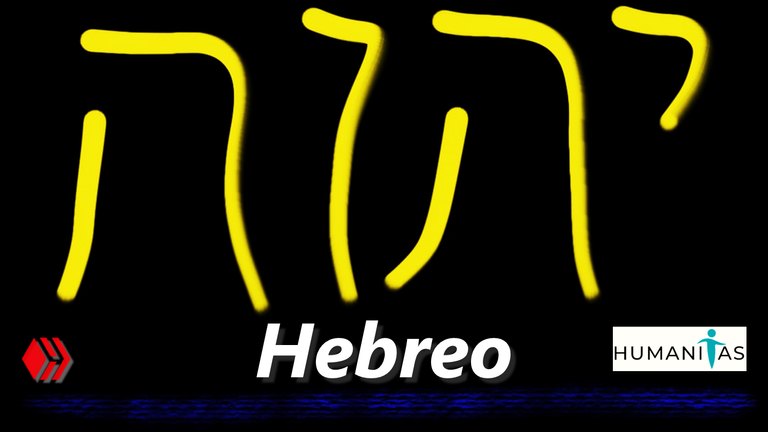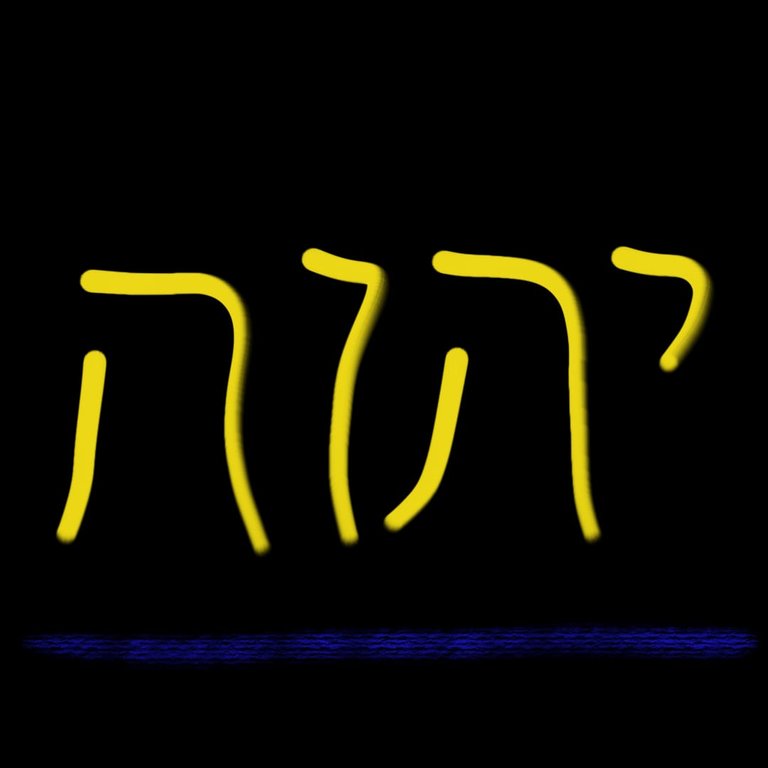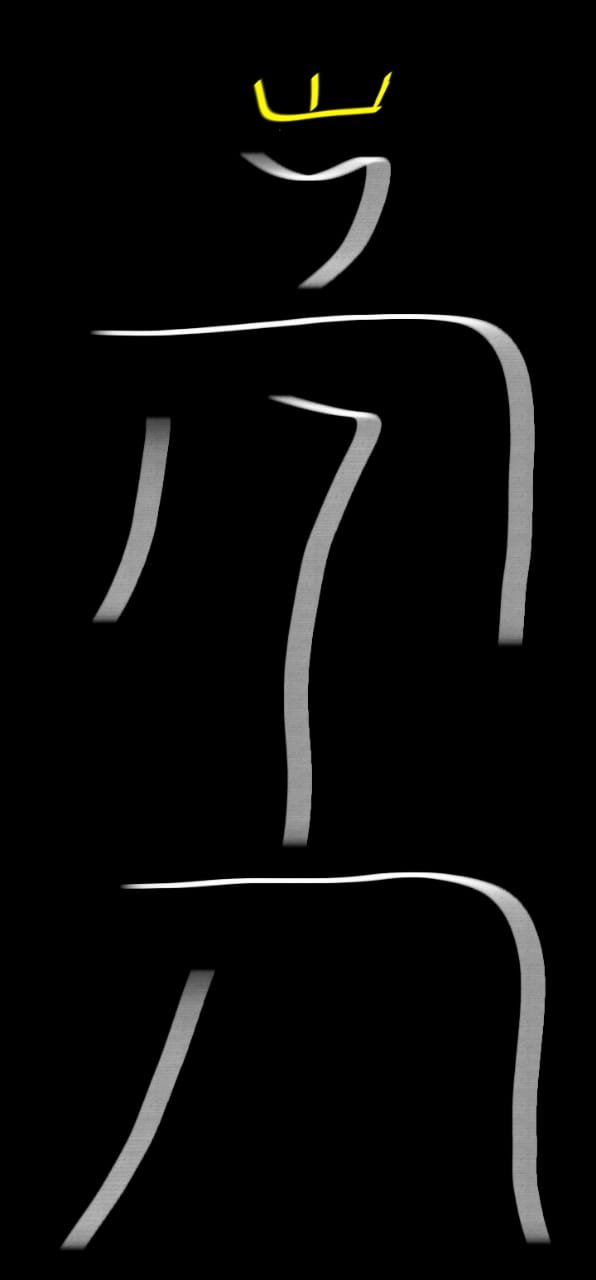Una simple interpretación gráfica del nombre de Dios יהוה 📖👑
¡Saludos a todos y feliz año 2024! Me gustaría iniciar este nuevo año en mi blog de Hive con una publicación que tenía guardada desde hace un tiempo en mis borradores pero que no me había animado a maquetar y postear. Se trata de algo que es quizás una casualidad curiosa que encontré estudiando un poco el idioma hebreo y quería compartirles aquí en la comunidad #Humanitas.
Click here for the English Version
Greetings to all and happy new year 2024! I'd like to start this new year on my Hive blog with a post that I had saved for a while in my drafts but hadn't gotten around to layout and publish. It is something that is perhaps a curious coincidence that I found while studying a bit of Hebrew language and I wanted to share with you here in the #Humanitas community.

Vamos con un poco de contexto. Quizás no muchos en occidente saben que en la Biblia en su idioma original Dios no tiene un solo nombre. El Antiguo Testamento en hebreo revela cosas que quizás se pierden un poco en las traducciones a idiomas occidentales, ya sea latín, inglés o español. El primer versículo menciona el nombre Elohim (אֱלֹהִים). De igual forma, a lo largo del texto hebreo se mencionan los nombres Adonai (אֲדֹנָי), El Shaddai (אל שדי), entre otros, pero en esta publicación nos enfocaremos en uno muy especial y a la vez misterioso, el cual se escribe: יהוה.
יהוה es quizás el nombre de Dios más importante y enigmático, también conocido como el "Tetragramaton". Se dice que no tiene pronunciación conocida, cosa que afirman los judíos, aunque a través del tiempo ha adoptado ciertas formas de pronunciación como "Yahveh" o "Jehová", especialmente a través de denominaciones del cristianismo.
Este nombre está compuesto por 4 letras hebreas: Yod (י), Hei (ה), Vav (ו), Hei (ה). El hebreo se lee de derecha a izquierda, por ello el orden diferente en que se nombran las letras respecto a como se ve escrito. Cabe destacar que una letra se repite dos veces. Podríamos decir que cada una de estas letras tiene su propio significado, y profundizaremos un poco en ello más abajo.
Click here for the English Version
Let's go with a little context. Perhaps not many in the West know that in the Bible in its original language, God does not have only one name. The Old Testament in Hebrew reveals things that may be lost in translations into Western languages, whether Latin, English, or Spanish. The first verse mentions the name Elohim (אֱלֹהִים). Similarly, throughout the Hebrew text the names Adonai (אֲדֹנָי), El Shaddai (אל שדי), among others, are mentioned. Still, in this publication, we will focus on a very special yet mysterious one, which is spelled: יהוה.
יהוה is perhaps the most important and enigmatic name of God, also known as the "Tetragrammaton". It is said to have no known pronunciation, which is claimed by Jews, although over time it has adopted certain forms of pronunciation such as "Yahweh" or "Jehovah", especially through denominations of Christianity.
This name is composed of 4 Hebrew letters: Yod (י), Hei (ה), Vav (ו), Hei (ה). Hebrew is read from right to left, hence the different order in which the letters are named concerning how you see it written. It is worth noting that a letter is repeated twice. We could say that each of these letters has its meaning, and we will go a little deeper into this below.

En este post vamos a dar una pequeña interpretación gráfica a este nombre de Dios. Es bastante curioso en realidad, y seguro no soy el primero en darse cuenta de esto. Pero antes de mostrar el dibujo que he realizado, vamos a "añadir" un pequeño detalle a este nombre de Dios. En realidad, no es algo que se ha añadido, sino más bien es algo que en teoría siempre ha estado allí.
Hay una manera de escribir el hebreo bíblico que es mucho más "formal" y repleta de detalles. En esta forma, las letras poseen "coronas". De esta manera, la letra Yod (י) tendría una especie de corona arriba. Quizás las demás letras también podrían llevar su corona, pero sólo nos enfocaremos en la primera letra: Yod (י). La corona es algo que nos recuerda inmediatemente a los reyes. Es un símbolo de poder y de liderazgo por sobre todos.
Ahora, vamos a nuestro pequeño dibujo. Vamos a ordenar las letras del nombre יהוה en vertical. Cada una de estas letras representa algo, pero ya nos vamos a dar cuenta de que ordenadas de esta manera parecen simbolizar algo, que de hecho nos resulta muy familiar:
Click here for the English Version
In this post, we are going to give a little graphic interpretation of this name of God. It's quite curious actually, and I'm sure I'm not the first one to realize this. But before showing the drawing I have made, let's "add" a little detail to this name of God. Actually, it is not something that has been added, but rather it is something that in theory has always been there.
There is a way of writing biblical Hebrew that is much more "formal" and full of detail. In this form, the letters have "crowns". Thus, the letter Yod (י) would have a kind of crown on top. Perhaps the other letters could also wear their crown, but we will only focus on the first letter: Yod (י). The crown is something that immediately reminds us of kings. It is a symbol of power and leadership above all.
Now, let's go to our little drawing. Let's arrange the letters of the name יהוה vertically. Each of these letters represents something, but we are already going to realize that arranged in this way they seem to symbolize something, which is very familiar to us:

No sé si se trata de alguna casualidad o no, pero no se puede negar que resulta muy curioso. Lo que muestran estas letras ordenadas en vertical parece ser una figura humana, que además porta una corona. Posee una cabeza, en la cual piensa e imagina. Posee brazos (y manos), con los que es capaz de crear cosas. Posee un torso, el cual le da orden, estabilidad, sostèn y conexión a la estructura de arriba a abajo. Posee piernas, con las que camina y se apoya en la tierra, y le permiten caminar. Y, por supuesto, posee una corona, simbolizando su poder.
No podemos pensar en esto como el poder de un rey despiadado al estilo medieval, sino más bien el poder que el ser humano tiene en su interior. Esto es el ser humano, una representación de lo que es capaz, e inclusive de sus defectos e imperfecciones, ya que una falla en algún lugar de estas 4 "áreas" le afectará en cierta medida. Ahora, desde mi percepción, no se trata de una especie de exaltación del ser humano al mismo nivel o por encima de Dios, sino más bien una especie de representación simbólica de la imagen o semejanza por la cual nos creó.
Quizás lo que podemos aprender es que el ser humano es capaz de ser rey de sus propias emociones, una tarea para nada fácil, pero que nos ayuda a crecer.
Espero que hayas disfrutado esta lectura. Gracias por visitar mi blog ¡Hasta la próxima!
Click here for the English Version
I don't know if it is a coincidence or not, but it can't be denied that it is very curious. What these letters arranged vertically show seems to be a human figure, who also wears a crown. It has a head, in which it thinks and imagines. It has arms (and hands), with which it can create things. It has a torso, which gives order, stability, support, and connection to the structure from top to bottom. It has legs, with which it walks and rests on the ground, and allows it to walk. And, of course, it has a crown, symbolizing its power.
We cannot think of this as the power of a medieval-style ruthless king, but rather the power that the human being has within him. This is the human being, a representation of what he is capable of, and even of his flaws and imperfections since a flaw somewhere in these 4 "areas" will affect him to some extent. Now, from my perception, it is not a kind of exaltation of the human being to the same level or above God, but rather a kind of symbolic representation of the image or likeness by which he created us.
Perhaps what we can learn is that the human being is capable of being king of his own emotions, not an easy task at all, but one that helps us to grow.
I hope you enjoyed this reading. Thanks for visiting my blog, see you next time!
Imágenes creadas mediante la App Sketchbook
Translated to English language with the help of DeepL.com
Otras redes sociales:
 |
 |
 |
F1 & motorsports: @acontmotor
Secondary blog: @acontblog

| ¡Gracias por visitar! — ¡Thanks for visiting!  |
#POSH X
https://twitter.com/acontcivil/status/1741959028681363892
Es súper interesante. Algunos rabinos estudiosos plantean que el nombre de dios no sea un nombre propio sino una especie de interjección onomatopeyica que decían los hebreos cuando veían llegar a ese ser. Otra cosa es según la biblia dios reveló su nombre alrededor del año 1400 a, pero los hebreos.en ese entonces no tenían una identidad nacional ni lengua propia, ellos hablaban egipcio al igual que Moisés, por lo que la cuestión pudo haber Sido muy diferente a lo que quedó registrado en la biblia. Recomiendo el canal de Youtube del prof César Silva que es un estudioso del lenguaje hebreo antiguo y explica muchas cosas que para nosotros están veladas por las traducciones.. buen post
Es muy curioso e interesante @fixie. No sabía algunas de esas cosas. Buscaré ese canal a ver qué información ofrece.
¡Saludos y gracias por comentar!
Interesante.
Also. Each letter has an original symbol/ meaning .
Yud = Hand
Heh = Behold
Vav = Nail
Heh = Behold
Hand, behold the Nail, behold …
That is very interesting. Hebrew is a very enigmatic language.
Saludos, amigo, y feliz año 2024. Ciertamente, esta frase hebrea impronunciable tiene mucho que decirnos, recuerdo por ejemplo en las clases del seminario que una interpretación teológica de esto es que no le podemos dar nombre a Dios, ya que cuando uno nombra una realidad la está poseyendo, y Dios está más allá de toda realidad y es más allá de lo que podamos definir.
Por otra parte, esta otra interpretación que has compartido es muy interesante, porque particularmente me hace pensar en Cristo Rey que se encarna para señalarnos un camino a los seres humanos, uno que va acorde a lo que afirmas el dominio interior de nosotros mismos.
!PIZZA
!KING
Your hard work has paid off King @acont, jesusalejos(3/6) is grateful for the passion and commitment you put into this post. Keep up the amazing work.
We are so impressed by your content! As a token of appreciation, @jesusalejos has sent you 50.0 BUDS. Keep shining!
BTW! BUDS is the token of the hashkings ecosystem, you can use it to have discounts in all our games or stake it and earn rewards now!
Feliz año 2024 @jesusalejos! bendiciones para ti. Es muy curioso lo que se forma con dicho nombre con las letras en vertical. Sin duda que alguna relación existe con Cristo, y el dominio interior.
¡Saludos!
$PIZZA slices delivered:
@jesusalejos(3/10) tipped @acont